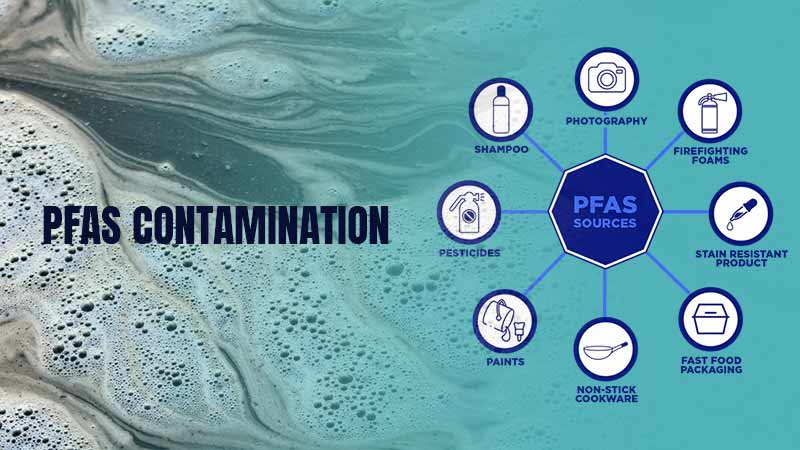
PFAS stands for poly- or perfluoroalkyl substances. These substances are a type of chemical that can be found in products such as non-stick cookware, waterproof clothing, and food packaging.
If you’ve been following the news lately, you may have seen reports about “forever chemicals” or perfluoroalkyl chemicals (PFAS) in drinking water. These industrial chemicals have been used for decades in a variety of products, from nonstick cookware to waterproof clothing, and they’re now known to be present in the environment and in the human body at low levels.
So, what are these chemicals, and why are they a concern? Here’s what you need to know about PFAS contamination.
Perfluoroalkyl chemicals are a group of man-made chemicals that contain fluorine, an element that gives them unique properties such as resistance to heat, oil, stains, and water. Because of these properties, PFAS has been used in a wide range of products over the years, including Nonstick cookware, Waterproof clothing, Stain-resistant fabrics and carpeting, Firefighting foam, and Fast food wrappers. However, PFAS can also be found in: Drinking water (if there is an industrial facility nearby that uses or has used PFAS), Food (especially meat and fish that come from areas where drinking water is contaminated with PFAS), Soil (near industrial sites or landfills that contain PFAS)
PFAs can infiltrate your neighborhood through a number of different channels, including groundwater and drinking water sources. If you think you may have been harmed by Pfas-contaminated water, it’s crucial to consult with a lawyer about your legal rights and file a PFAS water contamination lawsuit. An attorney can help you decide whether you are to blame for the contamination and can provide you with advice on how to seek compensation.
How can PFAS Contamination Cause Cancer?
PFAS contamination can cause cancer because the chemicals can accumulate in the body and build up over time. When these chemicals build up, they can cause damage to cells and DNA, which can lead to cancer. Additionally, PFAS contamination can also cause other health problems such as liver damage, endocrine disruption, and reproductive problems.
There is a growing body of evidence linking PFAS exposure to a variety of adverse health effects in humans, including:
- Increased risk of cancer
- Hormonal disruptions
- Thyroid problems
- Immune system dysfunction
- High cholesterol
- Weight gain
- Liver damage
While more research is needed to confirm the exact mechanisms by which PFAS contributes to these health problems, it is clear that exposure to these chemicals can have serious consequences for human health. If you suspect that you may have been exposed to PFAS, it is important to talk to your doctor and get tested for these contaminants.
Is PFAS Contamination Safe?
There is a great deal of controversy surrounding PFAS contamination. Some people assert that it is perfectly safe, while others maintain that it is a serious health hazard. The truth probably lies somewhere in between.
PFASs are a group of chemicals that have been used in a variety of industries for many years. They are resistant to heat, oil, water, and stains, which makes them ideal for use in non-stick cookware, waterproof clothing, and carpeting. However, PFASs are also persistent organic pollutants (POPs), meaning they do not break down easily in the environment and can accumulate in the bodies of animals and humans who are exposed to them.
There is some evidence that PFAS exposure can lead to adverse health effects in humans, including liver damage, thyroid problems, immune system suppression, and cancer. However, much of the research on PFASs has been conducted on animals, so it is not clear how applicable these findings are to humans. Additionally, most studies have looked at exposure to high levels of PFASs, so it is not known if lower levels of exposure are also harmful.
Because of the potential risks associated with PFAS exposure, it is important to be aware of sources of PFAS contamination and take steps to minimize your exposure. If you live near a site where PFASs have been released into the environment, or if you regularly eat food or drink water that may be contaminated with PFASs, you may want to talk
How to Get Rid of PFAS Contamination
If you think you may have been exposed to PFAS, it is important to seek medical attention and consult with a healthcare professional. If you have been exposed to high levels of PFAS, you may need to be treated with chelation therapy.
There are also some things that you can do to minimize your exposure to PFAS and reduce the risk of contamination. Here are a few tips:
- Filter your drinking water using a reverse osmosis filter or an activated carbon filter.
- Avoid using non-stick cookware and fast food wrappers.
- Use natural cleaning products in your home.
- Wash your hands after coming into contact with any potential sources of PFAS contamination.
- Avoid using products that contain Teflon or other synthetic chemicals.
What We Know and Don’t Know About PFAS Contamination and Cancer
There is a great deal of controversy surrounding PFAS contamination and cancer. Some studies have linked PFAS exposure to various types of cancer, while other studies have found no link. The truth is that we don’t yet know enough about the potential health effects of PFAS exposure to make a definitive statement about whether or not it causes cancer.
There are two main types of PFAS: perfluorooctane sulfonate (PFOS) and perfluorooctanoic acid (PFOA). Both of these chemicals have been used in a variety of products, including non-stick cookware, food packaging, and stain-resistant fabrics. They are also present in some firefighting foams.
Exposure to PFAS can occur through ingestion, inhalation, or skin contact. Once they enter the body, PFAS can stay there for years because they are very resistant to breakdown.
There is some evidence that PFOS and PFOA may increase the risk of certain types of cancer, including testicular cancer, kidney cancer, and thyroid cancer. However, it’s important to note that these studies are not definitive, and more research is needed to confirm any potential link between PFAS exposure and cancer. If you are concerned about your exposure to PFAS, there are some steps you can take to reduce your risk.
Conclusion
PFAS contamination is a serious issue that needs to be addressed. If you suspect that your water may be contaminated, it’s important to have it tested and to take steps to protect yourself and your family from exposure. While there is no easy solution to the problem of PFAS contamination, awareness and education are critical first steps in protecting our communities and our environment.











